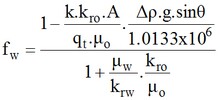|

  
|
||
The diffuse flow condition can be encountered under two extreme physical conditions:
| a. | when displacement occurs at very high injection rates so that the condition of vertical equilibrium is not satisfied and the effects of capillary and gravity forces are negligible, and |
| b. | for displacement at low injection rates in reservoirs for which the measured capillary transition zone greatly exceeds the reservoir thickness and the vertical equilibrium condition applies. |
Diffuse flow is where the fluid saturations at any point in the linear displacement path are uniformly distributed with respect to thickness. The sole reason for making this assumption is that it permits the displacement to be described, mathematically, in one dimension and this provides the simplest possible model of the displacement process.
The following describes the method and physics governing diffuse flow displacement through a linear homogeneous cross section of a reservoir, as outlined by Dake1.
| 1. | Calculate the fractional flow curve, from the following equation, allowing for gravity effects but neglecting capillary pressure. |

| 2. | Calculate the tangent to the fractional flow curve, from the point Sw = Swc & fw = 0. The point of tangency has the coordinates Sw=Swbt & fw=fwbt, and the extrapolation of this line to fw=1 gives the value of the average saturation behind the front at breakthrough. |
The following equations can be applied to calculate the oil recovery and time at which breakthrough occurs.


| 3. | Applying the following equation to all Sw values greater than Swbt, with coordinate values of Swe & fwe, will result in the average water saturation in the reservoir block. |

| 4. | For each value of Swe, the average water saturation is calculated and the subsequent oil recovery is calculated from the following equation. |
![]()
Wid, the number of pore volumes of water injected, is calculated from the reciprocal of the slope of the fractional flow curve, and is used to attach a time scale to the oil recovery from the following equation.
![]()
References:
Dake, L., "Fundamentals of Reservoir Engineering", Elsevier Scientific Publishing Company, 1978.
Page url: http://www.YOURSERVER.com/help/index.html?introduction3.htm